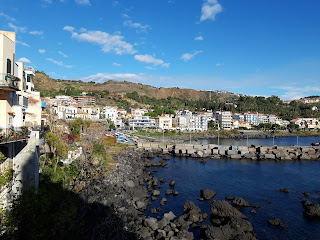More holiday photos from last year. After Turkey we set sail westwards across the Med to Sicily (passing Crete on the way, again). We docked at Catania, which I've flown to before but never arrived there by ship.
Catania at dawn, with Etna looming in the distance.
Etna was erupting quite actively (you can see the main ash plume and puffs of gas) from the main crater. There was a lava flow on the far side but not visible from here unfortunately. Catania is a lovely Sicilian city and looked charming in the morning sunlight. Last time I was here it poured with rain.
A couple of coastguard ships in the harbour.
We set of up the coast for a brief trip, those rocks are the supposedly the ones Polyphemous the cyclops threw at Odysseus as he sailed past.
There was this rather fine castle built onto and into the volcanic rock.
More of a view up the coast. This are was settled by the Phoenicians and slightly further up the coast south of Taormina is Giardini Naxos, the first Greek settlement on the island.
We all know who this is.
The castle was very fine close up. Sadly it was closed.
As the coast here is primarily composed of lava flows from Etna, it is exceedingly rocky.
There aren't really any beaches, so the local fisherman have adopted ingenious solutions to getting their boats on shore. Here are log rollers/supports.
You can see the lava cliffs quite well here.
This is a postwar statue commemorating the privation and mass starvation on the island.
Back to Catania, which still has many old buildings. The city was virtually entirely destroyed by an earthquake in the eighteenth(?) century so the older buildings date from the cities reconstruction. It was also heavily damaged in the war, so many of the buildings had to be rebuilt again.
Typical narrow streets. They provide a lot of shade as it was still blazing hot, even in November.
This is the remains of the Roman ampitheatre. Some of it is exposed to the air but much of it is underneath later buildings.
A small part surviving above ground.
St. Agatha is the patron saint of Catania. She suffered an agonising martyrs death, and she is commemorated all over the city.
The entrance to the main square. Much of the stone used is very dark is it is volcanic, which gives the buildings a very unusual appearance.
The Cathedral.
And more sideroads off the square.
This is a Roman elephant, carved out of volcanic rock.
What a great statue.
There were various other churches around, with the sun bouncing off the limestone.
The Triskele is the symbol of the island. Shared with the Isle of Man!
Inside the cathedral.
The oldest surviving archway. I can't remember if this is Roman or Norman, Roman I think.
The tomb of Bellini.
These are the base of the original pillars (I'm going to say Roman/Byzantine). The rebuilt cathedral was much bigger so had new (bigger) pillars.
St Agatha.
What a lovely cathedral, well worth a visit.
In a slight change of pace, we walked around the outdoor markets. These are fresh fish stalls.
Fruit and Veg.
And various lovely buildings around the side roads.
The elephant theme continued.
This is the entrance to the underground sections of the ampitheatre. You can see from the arch in the distance how big it was.
The wind changed direction a bit later in the day so the plume headed our way a bit more but there wasn't much ash around. Last time I was here there had been a big eruption and there were inches of ash all over the place,
A bit of a flying visit but nice to be back. One day I'll make it to Western Sicily, but not this time.
















































No comments:
Post a Comment